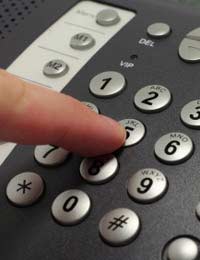Telephone Switchboards: How they Work

We will all at some time have made a call to company only to find the call answered by a receptionist and then put on hold while she tries to connect us to the correct extension number. To do this she is using a telephone switchboard, here we look at these pieces of telephony equipment normally found in offices and explain how they work.
What is a Switchboard?
A switchboard is a piece of telephony equipment that is connected to the telephone lines coming into your office block or place of work. This 'board' is actually a large telephone in itself with a series of separate extensions that can be connected to the individual lines entering the building, thus enabling the operator to answer, hold, forward or cancel calls sometimes more than one at a time.Parking a Call
Parking a call refers to receiving a call through the switchboard and putting it on hold while the receptionist tries to locate the relevant person at the correct extension number. Sometimes however the person is away from their desk so the call is 'parked'; this means that the call is held while the receptionist tries other extension numbers or puts out an internal tannoy message to alert the individual they have a call. Whilst the call is 'parked' the caller may here important messages about the business such as closing dates for holidays or indeed may just hear music playing.Conference Calls
This is effectively the process of having a meeting via telephone where two or more people can engage in the call from their separate extensions. This is a particularly useful function of a switchboard if one or more of the individuals involved are not on-site at the time. Calls are routed and 'batched' together so they can be heard by those individuals who have requested to do so.Answering Services
You may have called an office to speak with someone only to find they are not there. The receptionist may well ask if you would like to leave a message and if you say yes then the call is put through to their voicemail. This is a voicemail similar to those used by mobile telephones and the messages recorded are stored on hard drive for retrieval later by the owner of that extension. Messages are only retrievable if the person at that extension enters a pre-designated PIN (Personal Identification Number).Direct Dialling
Most switchboards have the facility that allows the customer on the outside to call into the switchboard and - if they know the extension number they want - they can dial it from their own telephone keypad without having to speak to a receptionist. Indeed many companies offer the facility whereby the last four digits of a telephone number are the number of an extension and using a prefix plus the last four digits allows you to dial straight to the extension without going through the switch board.Switchboards are an important part of office life and often when they malfunction many offices find it difficult to deal with queries etc by telephone until the problem is resolved. Again as the technology becomes more sophisticated it becomes a lesser requirement to have a human being man such equipment.
Related Articles in the 'Technology' Category...
- Communicating With Social Media
- Keeping in Touch with Existing Customers
- Digital Telephones Explained
- Using Computers to Route Telephone Calls
- Getting The Most From Your Mobile Phone
- Having a Manned Messaging Service
- Calling Premium Rate Numbers
- Sending Voice Files by E-Mail
- What is VOIP (Voice over IP)
While I'm sure there are still switchboards and receptionists, it seems as if every time I try to call a company, everything is in an automated system, and the voice guiding me through it is pre-recorded. I'm sure this is all well and good, and probably saves plenty of money for the company, but it's very frustrating to the caller, especially when the system doesn't function as well as it should. Bring back the receptionist, I say. Nothing beats a live person at the other end of the line.
Edward - 2-Jul-12 @ 2:08 PM


Re: Telephone Banking Pros & Cons
Thanks
Re: Telephone Banking Pros & Cons
fdsfdsfdsadsadadad
Re: Asking to Speak to a Supervisor
You keep saying ‘you have the right’, but what exactly are the right surrounding a manager speaking to you? Do they really…
Re: Advertising and the Law
Had always enjoyed debating, arguing and standing up for a cause. Was active on the school council and chaired their meet- ings. Left…
Re: Advertising and the Law
Had always enjoyed debating, arguing and standing up for a cause. Was active on the school council and chaired their meet- ings. Left…
Re: Advertising and the Law
Had always enjoyed debating, arguing and standing up for a cause. Was active on the school council and chaired their meet- ings. Left…
Re: Avoiding Telephone Fraud
I feel like this website is highly abusive to children... It scares me because I too beat my children and it feels great. But I only do…
Re: Avoiding Telephone Fraud
I love to do this a lot. It gives lot of money. Have you recently been in a car crash. (My favourite tactic) I now know how to…
Re: What Makes a Good Public Speaker
This does not help me what’s so ever. I can’t hear English because of my disability of short term memory loss. I can speak…
Re: What Makes a Good Public Speaker
Thank you. I have had problems speaking publicly in the past. My main issue is my business speaks Liverpool and it isnt my…